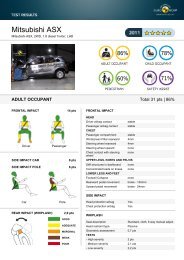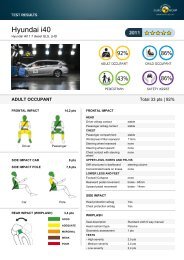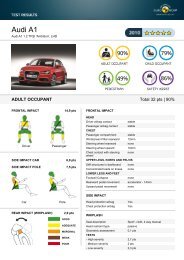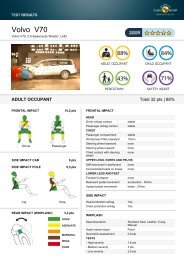Whiplash Testing Protocol - Euro NCAP
Whiplash Testing Protocol - Euro NCAP
Whiplash Testing Protocol - Euro NCAP
You also want an ePaper? Increase the reach of your titles
YUMPU automatically turns print PDFs into web optimized ePapers that Google loves.
5 H-POINT MACHINE & DUMMY POSITIONING<br />
5.1 Introduction. The following section contains the current positioning procedure for use with<br />
the BioRID dummy. The entire process for a single installation and measurement using the<br />
HPM and HRMD should last approximately 15 minutes maximum per installation.<br />
5.2 H-point manikin and HRMD preparation. The BioRID test position is based on reference<br />
measurements made with the H-point manikin (HPM) and HRMD. Parts of the following text<br />
contain excerpts from “A Procedure for Evaluating Motor Vehicle Head Restraints” (issue 2,<br />
RCAR, February 2001). A specific pairing of manikin and HRMD must be used which have<br />
been certified together. Before using the combination, ensure that the build condition is<br />
correct. Remove the head room probe from the H-point machine and install the two washers<br />
(supplied with the HRMD) in the spaces remaining on the H-point pivot. The fit of the<br />
HRMD on the H-point machine should be confirmed. Lower the HRMD in position onto the<br />
torso weight hangers and onto the top edge of the channel between the torso weight hangers.<br />
Ensure that the HRMD fits easily into place without inducing forces which might disturb the<br />
manikin position.<br />
5.3 H-point manikin installation<br />
5.3.1 The seat shall be covered with a cotton cloth large enough to cover both cushions and<br />
seatback.<br />
5.3.2 The cloth shall be tucked into the seat joint by an amount sufficient to prevent hammocking<br />
of the material.<br />
5.3.3 The H-point manikin shall be installed in the seat.<br />
5.3.4 The lower legs shall be adjusted to the 50 th percentile leg length setting, and the upper legs<br />
shall be adjusted to the 10 th percentile leg length setting; these are the HPM settings closest to<br />
the <strong>Euro</strong> <strong>NCAP</strong> front and side impact protocol settings.<br />
5.3.5 The legs shall be attached to the HPM and set to the 5 th position (no.5) on the knee joint T-bar,<br />
which places the knees 250mm apart.<br />
5.3.6 With the legs attached and the back pan tilted forward, the HPM shall be positioned in the<br />
seat such that its mid sagittal plane coincides with the longitudinal centreline of the seat. The<br />
centreline of the seat may be defined from features such as the head restraint support tubes or<br />
seatback and seat pan side bolsters. Particular attention should be paid to seats with<br />
asymmetric design.<br />
5.3.7 The back pan shall be straightened to conform to the vehicle seat back.<br />
5.3.8 The feet shall be placed as far forward as possible, with the heels resting on the heel plane and<br />
the feet positioned at 90° to the tibias. The toe pan shall be positioned sufficiently far away so<br />
as to avoid any interaction with the feet during the HPM installation process.<br />
5.3.9 The lower leg and thigh weights shall be attached to the HPM and the assembly shall be<br />
levelled.<br />
Version 3.1<br />
June 2011<br />
14
















